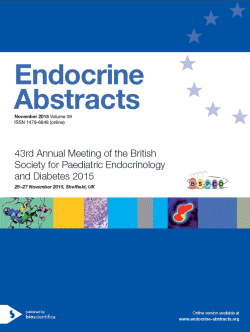Searchable abstracts of presentations at key conferences in endocrinology

43rd Meeting of the British Society for Paediatric Endocrinology and Diabetes
Contents
- CME Training Day Abstracts
-
- (1)
-
-
ea0039cme1
-
ea0039cme3
-
ea0039cme4
-
ea0039cme5
-
ea0039cme6
-
ea0039cme7
-
- Main Symposia
-
- Industry sponsored Satellite Symposium
-
-
ea0039symp1.1
-
- Symposia 1 Translational Endocrinology
-
-
ea0039s1.1
-
ea0039s1.2
-
ea0039s1.3
-
- Symposia 2 Bone
-
-
ea0039s2.1
-
- Symposia 3 Obesity and Type 2 Diabetes
-
-
ea0039s3.1
-
ea0039s3.3
-
- Symposia 4 Diabetes
-
-
ea0039s4.4
- Diabetes Professionals Session
-
- (1)
-
-
ea0039dp6
-
ea0039dp8
- Endocrine Nurse Session
-
- (1)
-
-
ea0039en1
-
ea0039en2
-
ea0039en4
-
- ORAL COMMUNICATIONS
- Poster Presentations
- e-Posters
-
- Adrenal
-
- Bone
-
- Diabetes
-
-
ea0039ep53
- Gonadal, DSD and reproduction
-
- Late effects of cancer treatment
-
- Miscellaneous/other
-
- Obesity
-
-
ea0039ep93
- Other
-
- Pituitary and growth
-
-
ea0039ep106
-
ea0039ep107
-
ea0039ep112
- Thyroid
-
-
ea0039ep123
-
ea0039ep128



